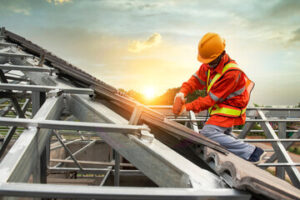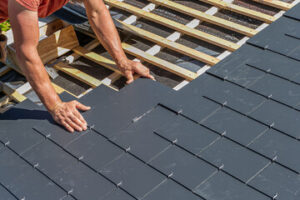Hiring Roofing Company Murfreesboro is essential for maintaining the integrity and safety of any building. Roofing plays a crucial role in protecting structures from weather, improving energy efficiency, and enhancing overall aesthetics.

Over the years, roofing technology and materials have evolved, introducing innovative solutions that improve durability, performance, and environmental impact. Homeowners and businesses now have more options than ever, making it possible to customize roofing systems based on specific needs and environmental conditions.
One of the most significant advancements in roofing is the development of synthetic materials that offer enhanced resistance to harsh weather conditions. Traditional roofing materials have limitations in terms of weight, moisture absorption, and heat resistance. Modern synthetic materials are lightweight yet highly durable, capable of withstanding extreme temperatures and heavy rainfall without compromising structural integrity. These materials are designed to reflect heat, reducing cooling costs and improving the overall energy efficiency of the building. The shift toward synthetic roofing solutions has significantly improved the lifespan and performance of modern roofs.
Green roofing systems have gained popularity as property owners seek eco-friendly alternatives. Living roofs, which involve the installation of soil and vegetation on the roof surface, provide natural insulation and improve air quality. These systems reduce stormwater runoff, lower urban heat island effects, and increase biodiversity. The added layer of vegetation protects the underlying roofing materials from UV exposure and temperature fluctuations, extending the roof’s lifespan. Green roofing requires specialized installation and maintenance, but the long-term benefits in energy savings and environmental impact make it a valuable investment.
Solar roofing technology has also become more accessible and efficient in recent years. Integrated solar panels, designed to resemble traditional roofing materials, allow homeowners to generate renewable energy without compromising the appearance of their roofs. These systems reduce reliance on grid electricity and lower energy bills while increasing the property’s value. Advances in solar cell technology have improved the efficiency and durability of these systems, making them a practical and aesthetically pleasing option for modern buildings. The combination of solar roofing and battery storage systems allows for greater energy independence and protection against power outages.
Roofing repair and maintenance have been transformed by the use of drone technology and infrared imaging. Drones equipped with high-resolution cameras can quickly inspect large or difficult-to-access roofs, identifying damage, leaks, and wear without the need for manual inspection. Infrared imaging detects moisture buildup and heat loss, allowing for early detection of underlying issues before they become major problems. This targeted approach reduces repair costs and minimizes disruption to the property. Roofing companies can now provide more accurate estimates and faster service thanks to these advanced diagnostic tools.
Innovations in roofing insulation have also contributed to improved energy efficiency and comfort. Reflective roof coatings, made from specialized polymers, reduce heat absorption and keep buildings cooler during hot weather. Insulating underlays, installed beneath roofing materials, create a barrier against heat transfer and noise pollution. These solutions enhance indoor comfort and reduce the load on heating and cooling systems, leading to lower utility costs. The use of sustainable insulation materials, such as recycled fibers and natural wool, further reduces the environmental footprint of roofing systems.
Metal roofing systems have gained renewed interest due to their durability and modern appearance. Advances in coating technology have improved the corrosion resistance and color retention of metal roofing materials. Metal roofs are lightweight, fire-resistant, and capable of withstanding high winds and heavy snowfall. They also reflect solar heat, contributing to energy savings. The ability to customize metal roofing designs with various finishes and textures has made them a popular choice for both residential and commercial buildings. Modern fastening systems and underlayment options have also improved the installation process, ensuring a secure and weatherproof finish.
Storm-resistant roofing systems have become essential in areas prone to severe weather conditions. Impact-resistant shingles, designed with reinforced materials, can withstand hail and debris without cracking or breaking. Wind-resistant roofing systems use specialized fastening methods and interlocking designs to prevent lifting and displacement during high winds. Waterproof underlays provide an additional layer of protection against water infiltration, reducing the risk of interior damage. The combination of these storm-resistant features ensures that modern roofs can withstand extreme weather and provide long-term protection.
Roofing ventilation has also seen improvements with the introduction of smart ventilation systems. These systems use sensors to monitor temperature and humidity levels within the attic and adjust airflow accordingly. Proper ventilation prevents moisture buildup, which can lead to mold growth and wood rot. Smart ventilation systems reduce the strain on HVAC systems, improve indoor air quality, and extend the lifespan of roofing materials. The integration of smart technology into roofing systems has enhanced overall performance and comfort for property owners.
Roofing aesthetics have become increasingly important as homeowners seek to enhance curb appeal and property value. Modern roofing materials are available in a wide range of colors, textures, and styles to match architectural designs. Composite shingles, designed to mimic the appearance of natural slate or wood, provide a high-end look without the associated maintenance costs. Custom color blends and multi-layered designs create depth and dimension, adding visual interest to the roof. The ability to combine aesthetics with durability and performance has made modern roofing systems more versatile and appealing.
Flat roofing systems have evolved with the introduction of advanced waterproofing membranes and drainage solutions. Traditional flat roofs were prone to water pooling and leaks, but modern materials and installation techniques have addressed these issues. Single-ply membranes, made from durable synthetic materials, create a seamless barrier against water infiltration. Integrated drainage systems, including tapered insulation and internal gutters, ensure that water is directed away from the roof surface. These improvements have made flat roofing systems more reliable and suitable for a wider range of applications.
Fire-resistant roofing materials have become a priority in areas vulnerable to wildfires and high temperatures. Class A fire-rated materials, including metal and treated asphalt shingles, provide the highest level of protection against fire exposure. Fire-resistant underlays and sealants further enhance the roof’s ability to withstand heat and flames. Roofing companies now offer specialized fire-resistant designs that meet local building codes and provide peace of mind for property owners. The use of non-combustible materials and proper installation techniques ensures that modern roofing systems are better equipped to handle fire-related risks.
The rise of prefabricated roofing systems has simplified the installation process and improved overall consistency. Prefabricated roof panels are manufactured off-site and delivered to the property for quick assembly. This approach reduces labor time, minimizes material waste, and ensures a higher level of precision during installation. Prefabricated systems are designed to meet specific building requirements, allowing for easier customization and integration with existing structures. The ability to install roofing systems more efficiently has reduced overall project costs and improved quality control.
Advancements in roof coating technology have also extended the lifespan of existing roofs and improved their performance. Elastomeric coatings, made from flexible polymers, provide a waterproof and UV-resistant barrier that expands and contracts with temperature changes. Reflective roof coatings reduce heat absorption and lower cooling costs. Coating systems can be applied to various roofing materials, including metal, asphalt, and concrete, providing an additional layer of protection against weather and environmental damage. These solutions have made it possible to restore and enhance existing roofs without the need for complete replacement.
The demand for sustainable roofing materials has led to the development of products made from recycled and renewable sources. Recycled metal, rubber, and plastic are now used to create durable and environmentally friendly roofing systems. Some roofing materials are designed to be fully recyclable at the end of their lifespan, reducing landfill waste and supporting a circular economy. The use of bio-based materials, such as plant fibers and natural resins, further enhances the sustainability of modern roofing systems. The combination of performance, aesthetics, and environmental responsibility has made sustainable roofing a preferred choice for modern property owners.
The future of roofing will continue to be shaped by technological innovation, environmental considerations, and changing consumer preferences. The integration of smart systems, improved materials, and advanced installation techniques will enhance durability, performance, and energy efficiency. Roofing companies that adopt these innovations and prioritize customer service will remain competitive in an evolving market. The ability to offer customized, sustainable, and high-performance roofing solutions will define the next generation of roofing systems and set new standards for the industry.
